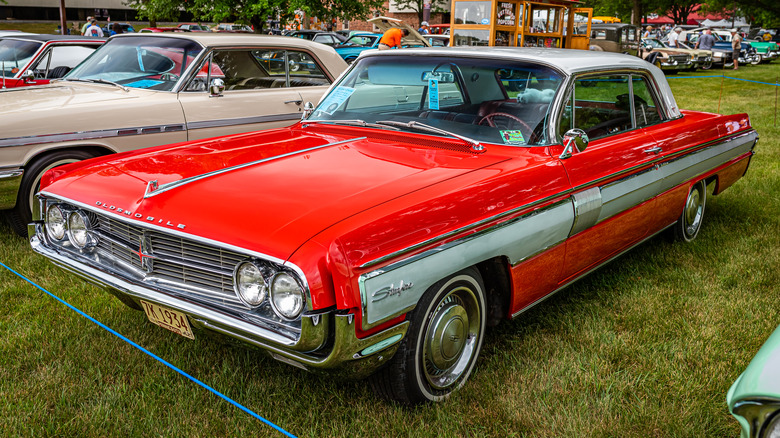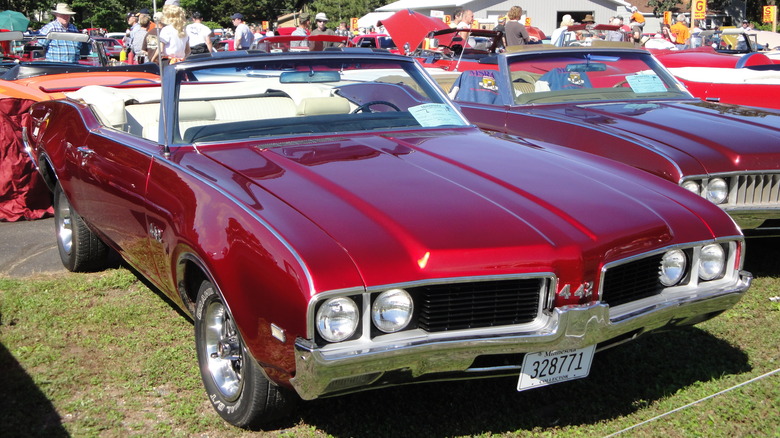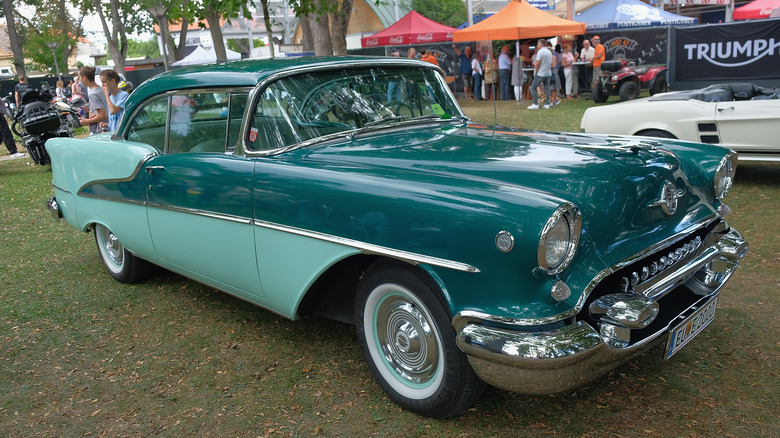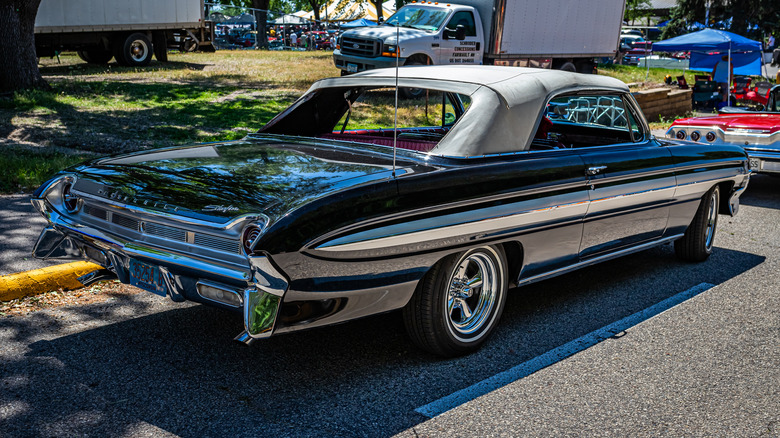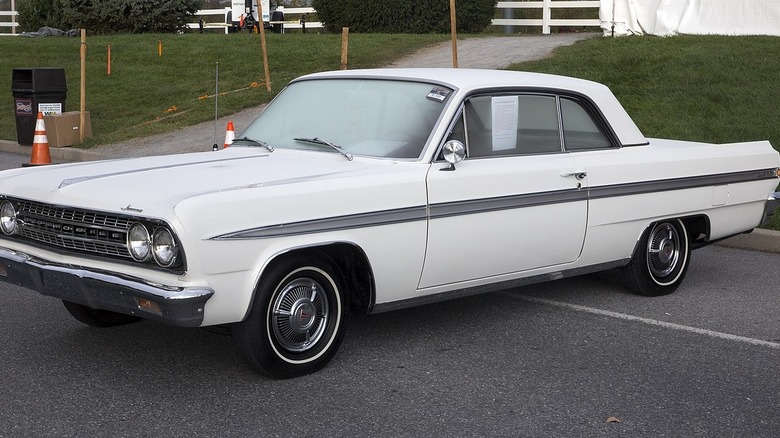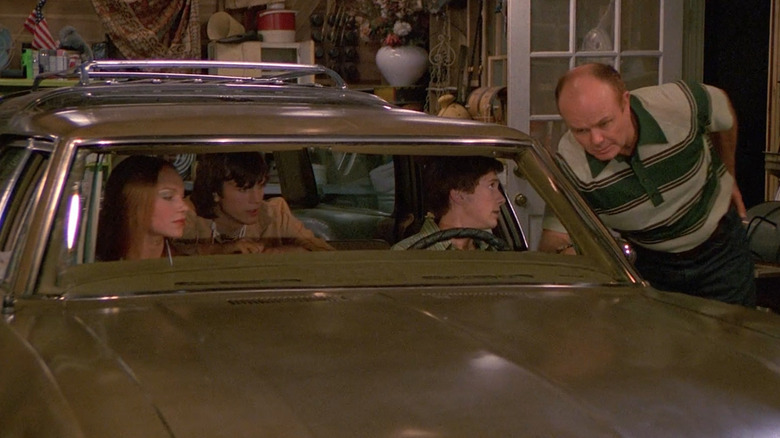5 Most Popular Classic Oldsmobiles, And What They're Worth Today
Ransom Eli Olds began working in his father's machine shop around 1880, where he helped build steam engines for yachts. After Karl Benz built the world's first car, the Motorwagen, Olds was inspired by his use of the internal combustion engine and secured a U.S. patent for a three-wheeled, gas-powered vehicle in 1896. The next year, the family business was renamed the Olds Motor Vehicle Company, and by the turn of the century, the public had begun calling their cars "Oldsmobiles."
Although Henry Ford is often credited with developing the auto industry's first assembly line to produce the legendary Model T, Ford simply refined and expanded on a concept brainstormed by Olds after a 1901 fire destroyed the company's facilities. Olds was forced to develop a way to produce cars more quickly and cheaply, and the brand grew rapidly.
Oldsmobile came under the General Motors umbrella in 1908, had a series of memorable achievements throughout the 20th century, and produced more than 35 million cars (via History) before flagging sales and a government bailout forced GM to dump the division in 2004. In its heyday, Oldsmobile made a handful of models that were a hit with the public, and some of them remain coveted by collectors to this day and fetch a sizable ransom (pun intended) on the used market.
1968-72 442
The Oldsmobile 442 began as a high-performance option on 1964 F-85 and Cutlass models that included a 330 cubic inch V8 along with a beefier suspension and clutch. The name came from the four-barrel carburetor, four-speed transmission, and dual exhausts and was initially styled as "4-4-2." The 442 was split off into its own model in 1968 when the hyphens were officially dropped.
It was intended to compete with early generations of the Chevy Corvette and GM's newly introduced soon-to-be-legend, the Pontiac GTO. 1968 was the first year for the Hurst/Olds 442, a special edition with a 455 cubic inch V8 that made 390 horsepower and 500 pound-feet of torque (via Driving Line). The 442 reverted to being an option on the Cutlass in 1972, just as the oil crisis and new emissions standards began to put the brakes on the American public's desire for big, gas-guzzling cars. Production of the 442 was highest in 1968 at about 33,600 units and dipped slightly over the next two years before plunging below the 10,000 mark in 1971 and '72.
The model's popularity during its peak years led Oldsmobile to bring the 442 name back several times over the next 20 years or so, but later editions of the 442 were hobbled by emissions restrictions and never matched the performance or desirability of the 1968-72 models, which average about $70,000 today.
[Featured image by Greg Gjerdingen via Wikimedia Commons|Cropped and scaled|CC-By 2.0]
Rocket 88
Although some regard the muscle car era as starting in the 1960s, Oldsmobile gave the concept a jump start in 1949 when it took the 135 horsepower, 303 cubic inch V8 engine from the full-sized 98 and dropped it in the smaller and lighter body of the 76. the Rocket 88 was an instant hit on the racetrack, serving as the Indy 500 pace car that year and winning more than half of the NASCAR races held between then and 1952.
The Rocket 88 also inspired the first rock-n-roll record, "Rocket 88" by Ike Turner and the Kings of Rhythm, recording under the name Jackie Brenston and the Delta Cats (Brenston played saxophone on the song). "Rocket 88" spent five weeks in 1951 atop the R&B charts, and the car was a hit as well, selling more than 79,000 units between 1949 and 1953.
The Rocket 88's overhead-valve V8 inspired copycats from other domestic manufacturers in the early '50s, and the model would later lose the 'Rocket' moniker and become simply the 88 and later the Eighty-Eight. It stayed in Oldsmobile's lineup almost to the turn of the century, and the Rocket V8 engine remained in production in various displacements through the late 1980s. The Rocket 88 made our list of the half-dozen most neglected Oldsmobile muscle machines, and first-gen examples currently trade hands for about $31,000. Outliers exist, however, and a modified 1950 Club Coupe sold last Spring for $60,500.
1961-66 Starfire
Oldsmobile first used the Starfire nameplate on a prototype model displayed at the 1953 GM Motorama show, taking the name from the Lockheed F-94-B fighter. The Starfire badge was used on Ninety-Eight convertibles from 1954-1956 and had luxurious features like a power top, windows, and seats. Production hovered below the 10,000 unit mark in each of those three years but skyrocketed to nearly 80,000 copies in 1957 when the lineup was expanded.
The Starfire badge then went on the shelf until 1961, when GM brought it back as a standalone model. The new Starfire had vertical fins on the hood and four-inch tall brushed aluminum panels on the sides that ran nearly the length of the car. The interior had some new touches as well: leather bucket seats and a console between them that housed the shifter and a tachometer. Production peaked at just under 42,000 units in 1962, then dipped to about 25,500 the next year.
By that time, other, newer models had begun to chip into Starfire's market share, and production fell to about 16,000 units per year until it was replaced by the Toronado after the 1966 model year. The badge was brought back in the late '70s, but that version never matched the 1961-66 run of 120,000 units. The convertible was the most popular Starfire in its heyday, and ragtops remain plentiful six decades later, averaging about $30,000 on the secondhand market.
Jetfire
An anomaly on this list is the Jetfire, which is more popular today than it was when it was first released. The Jetfire debuted in 1962 with one of the auto industry's earliest turbocharging systems under its long hood. Like the 442, it was initially an add-on to the F-85, which would become the Cutlass later in the decade. The Jetfire was only offered in 1962 and 1963, mainly because owners were unfamiliar with the technology, and many neglected to add the necessary mixture of distilled water, methanol, and rust inhibitor to the Turbo-Rocket tank under the hood. The turbo system would shut down if the tank ran dry, and many buyers took advantage of Oldsmobile's offer to replace the system with a conventional four-barrel carburetor setup beginning in 1965.
A production run of fewer than 10,000 units, but the Jetfire's rarity has made it a coveted relic today. On an episode of "Jay Leno's Garage," Leno called the Jetfire "extremely rare, very unusual, and a real piece of automotive history." Fewer than 150 are believed to survive intact today, according to Jim Noel, who restores the Turbo Rocket system and told Hagerty, "The system worked, but it also failed easily and was leak-prone. I was rebuilding my own for a long time. Other shops wouldn't touch them."
Jetfires are hard to find with the turbo system still installed, and three intact examples recently sold for about $30,000.
[Featured image by Mr. Choppers via Wikimedia Commons|Cropped and scaled|CC-By 3.0]
Vista Cruiser
The Vista Cruiser is probably best known to younger adults as the station wagon handed down from Red Forman (Kurtwood Smith) to his son Eric (Topher Grace) in the pilot episode of "That '70s Show," but for children of the non-fictional '70s, the Vista Cruiser was the car we took many of our formative road trips in. Despite Red's claim in a later episode that it was so badged because "You can literally cruise the vistas" in it, the name was inspired by the glass roof above the back seat and two transparent panels running along the edges of the wagon's rearmost section. The Vista Cruiser first hit the road in 1964, complete with an elevated front-facing rear seat and Rocket V8 engine up front.
The third generation appeared in 1973, sans glass roof panels due to new rollover standards. That didn't keep the Cruiser down; Oldsmobile made more than 24,000 that year, bringing the 10-year total past 265,000 units, and the Vista Cruiser stayed in the brand's lineup through 1977 sans Vista.
The car owned by the fictional Forman family was a 1969 model, and Wilmer Valderrama, who played Fez on the show, told Kelly Clarkson in 2021 that he purchased it from the props department for $500 near the end of the show's run in 2006. Valderrama got a tremendous bargain, as Vista Cruisers usually sell for over $10,000 and average about $25,000 on the used market, even without a Hollywood pedigree.
